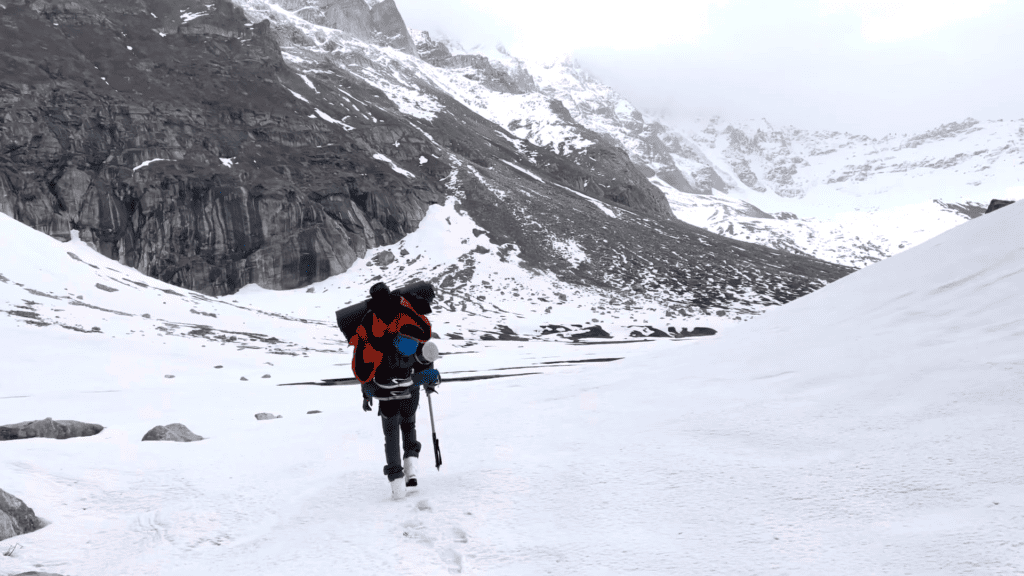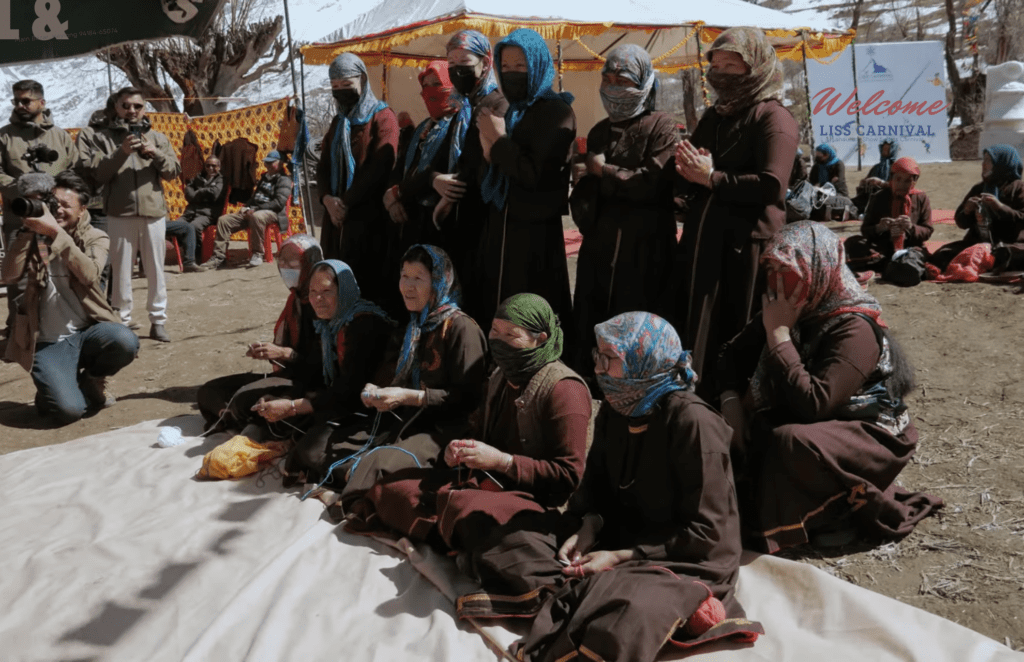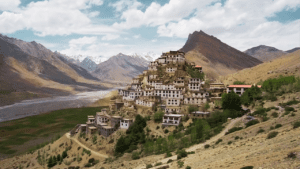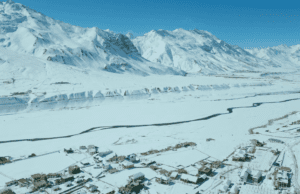Best Things to Do in Winter Spiti -Spiti Valley, literally meaning the land between the magnificent India & majestically Tibet. This place is the epitome of magic. From beautiful landscape to a rich culture heritage- there is nothing you cannot find here! Separated from Lahaul Valley by the soaring Kunzum La at 4551m, Spiti valley is a must visit destination in the months of October, November & December.
Spiti Valley is a cold desert mountain valley located high in the Himalayas in the north-eastern part of Himachal Pradesh. The name “Spiti” means “The Middle Land”, i.e. the land between Tibet and India. Winters in Spiti are extremely harsh and temperatures sometimes drop to as low as -20º Celsius. Winters here are frigid and there is no running water in taps. All that Spiti has in winters is the never-ending adventure and a white blanket of snow!
Known for its rugged terrain, a trip during winter gets a lot trickier. During this journey we cover regions in Kinnaur Valley, visit the famous Kalpa town and several known places of Spiti Valley, like Kaza, Kee, Kibber, and Langza.
Best Things to Do in Winter Spiti
Winter Spiti or Spiti Valley, also known as the adventure valley, offers an extensive list of activities that guests can enjoy. There are numerous benefits available to visitors in various areas of the valley. Despite the common belief that there isn’t much to do in Spiti during the winter, you can accomplish a lot if you have a strong will, perseverance, and a spirit of adventure. Among the winter activities in Spiti Valley are:
1. Go to the Monasteries
Visits to the monasteries in the Spiti Valley are among the best things to do in Spiti during the winter months because there are fewer tourists. With few obstacles, you can learn more about the cultural legacy of Buddhism. For centuries, the monasteries in the Spiti Valley have served as the spiritual hub of the area, drawing tourists who are looking for a place to find peace of mind even now. One can learn about the great teachings of Buddhism and immerse themselves in the rich cultural and religious traditions of the area by visiting these monasteries. here are monasteries to visit in winter spiti:
- Key Monastery
- Tabo Monastery
- Dhankar Monastery
- Lhalung Monastery
- Kungri Monastery
- Komic Monastery
- Gue Monastery
2. Hiking/ Trekking

A difficult but worthwhile experience can be had trekking in Spiti Valley in December. Walking in Spiti during the winter is an exciting experience because of the severe weather, but because of this, it should only be done by experienced trekkers. In Spiti, Komic villages, Langza, and Hikkim are a few of the most well-known trekking destinations in the winter.
Winter trekking in Spiti offers some genuinely amazing trekking experiences, but keep in mind that because of the difficult weather and restricted accessibility, winter trekking necessitates careful planning and preparation. Considering difficulty and scenery, these are some options for trekking in Spiti during the winter.
Chicham Trek: Stretching between Kaza and Chicham village, this comparatively easy three-day trek winds through breathtaking scenes covered in snow. It provides chances to socialise with locals and offers expansive views of the Spiti Valley.

Trekking the Langza, Hikkim, and Komic Circuit is a 4-day loop that links the world’s highest villages and provides stunning views of frozen rivers and snow-capped peaks. It’s a sensible choice for acclimatization prior to taking on longer hikes.
Trek to Dhankar Lake: This two-day journey takes hikers to the azure Dhankar Lake, which is surrounded by snow-capped mountains. A captivating vista is created by the icy lake and striking monastery.
3. Camping
Camping is a special and memorable experience, particularly during the winter Spiti. Numerous campgrounds provide additional activities, such as biking, hiking, and trekking. Before camping in the valley, a few things should be taken into account even though the experience is unmatched. Always keep in mind things like picking a suitable campsite, packing for the unexpected weather, drinking plenty of water, and being aware of the risks.
Marhi, if coming from the Manali side, before Khoksar, Gramphu, or Rohtang Pass
A variety of isolated towns and settings that provide an opportunity to meet people and learn about the way of life there
Chandratal, a well-liked camping location, and a few other isolated villages that now provide camping because of the increase in tourism
4. Spotting Snow Leopards
Finding a snow leopard in the Spiti Valley is a lifetime memory that will make a deep impression on your heart, no matter how fascinating it may sound. Spotting a snow leopard in its natural habitat is a truly once-in-a-lifetime experience, as the cat is an elusive species that is native to the mountainous regions of central Asia.
Some of the specific areas where snow leopards are often seen in Spiti Valley include Kibber Wildlife Sanctuary, Gue, and the surrounding remote and snow-clad wilderness
5. Participating in local festivities

Numerous festivals held exclusively in the winter months are held in Spiti Valley. These festivals give you a chance to get a close-up look at the customs and culture of the area. Several well-known winter celebrations in Spiti are the Ladarcha Fair, which attracts traders from nearby areas who engage in mutual trade; the Lossar Festival, which is believed to be the Buddhist New Year and is observed as an expression of thanks to the gods; and the Chaam Dance Festival, which features masked monks performing dances symbolic of the annihilation of all evil forces and negative energy.
Dachang Festival: which is held for seven days to a month around late February and March, and the Spiti Valley.
Participating in these festivals allows visitors to witness customs related to dance, music, and rituals that are exclusive to the winter months, offering a window into the region’s rich cultural diversity.
Common Problems in Spiti during the winter
One of the greatest places to go in the winter is definitely Spiti Valley, where the barren desert landscape transforms into a stunning white expanse with views that are unmatched. There are certain common problems that one can encounter in Spiti during the winter, but the winter wonderland offers you an experience unlike any other.
Extremely cold winter temperatures
Because of the valley’s high elevation, winter temperatures in Spiti Valley can reach -20°C in December. Long-term outdoor stays and travel can be prevented by the intense cold. To keep oneself warm in the winter, you must have on the proper apparel, such as hats, gloves, and insulated jackets.
Limited Stay Option
In Spiti Valley, many of the guesthouses and hotels close for the winter, and the ones that remain need additional amenities. To ensure you are warm and comfortable, it is advisable to reserve accommodations well in advance. You should also bring a warm blanket and a sleeping bag.
Limited eating options
In winter, Spiti Valley offers very few food options, and a lot of cafes and restaurants still need to open. To stay energized throughout the day, it’s a good idea to pack some non-perishable food items like chocolates, nuts, and biscuits. Also, you can eat real Thai food in the neighborhood, such as Momos and thukpa.
Snow Barriers
Heavy snowfall in December and January can cause roadblocks in Spiti Valley. Because of the streets’ narrow and winding layout, clearing snow can be difficult. As a result, it is wise to carry snow chains for your car and to check the state of the roads before starting the trip.
Restricted Connectivity
In winter, Spiti has poor connectivity; therefore, in certain areas, mobile networks and internet services should be stronger or more prevalent. That’s why, in the event of an emergency, having a satellite phone or a walkie-talkie with you is highly advised to stay in touch with your travel companions and the outside world.
Altitude Illness
Because of its high altitude and the bitterly low oxygen levels in the winter, Spiti Valley may cause altitude sickness in certain people. Drink lots of water, avoid alcohol and smoke, and acclimate gradually are all recommended.
How to reach Winter Spiti?
By Road:
From Manali:
The Manali route is generally open only during the summer months, typically from late May to early October, and involves high-altitude mountain passes like Rohtang Pass and Kunzum Pass. The journey to Kaza takes around 8-10 hours.
From Shimla:
The most common and reliable route is from Shimla. Through this route, reach Reckong Peo or Kaza, the main towns in Spiti Valley. The journey to Reckong Peo takes approximately 10-12 hours.
By Air:
The nearest airport to Spiti Valley is Bhuntar Airport, near Kullu and Manali. After landing at Bhuntar Airport, you can travel to Manali and then continue your journey to Spiti Valley by road. Several major Indian cities offer flights to Bhuntar Airport.
Q.1 How to reach Spiti Valley in winter?
There are various ways to travel to Spiti Valley during the winter, including by bus, car rental, road, airplane, and hiking.
By Road From Shimla, there is a common and dependable road route that takes approximately 10 to 12 hours during the winter.
Regular bus services are provided by the Himachal Road Transport Corporation (HRTC) between Reckong Peo and Kaza and Shimla and Manali. Bhuntar Airport, which is near to Kullu and Manali, is the closest airport to Spiti Valley for air travel. Driving to Manali and then Spiti Valley is an option once you land at Bhuntar Airport.
Q.2 What Exciting Activities Can You Enjoy in Spiti During Winter?
Activities available on your Winter Spiti Valley tour include skiing, snowboarding, ice-skating, stargazing, camping, photography, going to local winter festivals, and winter trekking.
Conclusion
For those looking for adventure and a look into the strong spirit of its people, wintertime in Spiti Valley is a singular and enthralling experience. The valley becomes an inviting yet difficult work of art, complete with frozen rivers, snow-covered mountains, and historic Buddhist monasteries.
Winter travel to Spiti is not for the timid; it requires planning and awareness of the challenging conditions.
But there are many benefits as well, like the friendly welcome from the people, the distinctive winter customs, and the breathtaking views that seem to come from another planet.
Experience the peace and quiet of this snow-covered paradise, learn about the rich cultural diversity of the area, and go on an unforgettable winter tour in Spiti.




